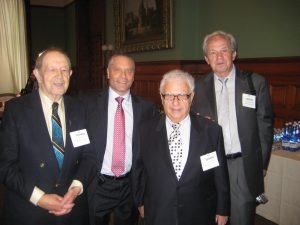“The hand of compassion was faster than the calculus of reason.” – Otto Springer, recognized by Yad Vashem as a Righteous Among the Nations on May 19, 1986.
What motivated thousands of non-Jews to risk their own lives in order to save the lives of Jews during the Holocaust when millions of others did not?
“I would do it all again.” Edeltrud Posiles uttered these words in 2011 when she was the last surviving Righteous Gentile who had hid Jews in Nazi Austria. When Posiles – then Becher – heard a knock on the door in 1942, she opened it to find her Jewish fiancé and his two brothers on her doorstep. As described at the DailyMail.com, “Hiding Jews was punishable by death. But the feisty 94-year old [said] ‘there was never a moment’s doubt in my mind,’ when asked if she hesitated as she was asked by the brothers for sanctuary.”
In October 1942, Jan Karski met clandestinely with Jewish leaders at the height of the destruction of Polish Jewry. As a courier for the underground, he delivered their dire message to the Polish government-in-exile in London. “The Jews were abandoned by governments, by church hierarchies, by existing societal structures. But they were not abandoned by all of humanity,” said Karski. “There were thousands upon thousands of people in Europe who risked their life for the Jews. They were priests, nuns, workers, peasants, enlightened ones, simpletons, from all walks of life. They were good people, very simply. We have more good people than probably we think we have in humanity.” Karski was recognized by Yad Vashem as a Righteous Gentile among the Gentiles on June 2, 1982
How many people like Karski were there? As of June 2017, the Yad Vashem award had been made to 26,513 people. The Database of the Righteous Among the Nations contains information about around 80 per cent of those recognized by Yad Vashem. The database can be searched by rescuer and by rescued person. Many of their stories and be read here.
But as also noted at yadvashem.org, “Attitudes towards the Jews during the Holocaust mostly ranged from indifference to hostility. The mainstream watched as their former neighbours were rounded up and killed; some collaborated with the perpetrators; many benefited from the expropriation of the Jews property.”
According to psychologist Eva Fogelman “Rescuers’ families nourished an independence of mind and spirit. … In talking with rescuers from all kinds of different homes, I found that one quality above all others was emphasized time and again: a familial acceptance of people who were different. This value was the centrepiece of the childhood of rescuers and became the core from which their rescuer self evolved. From the earliest ages, rescuers were taught by their parents that people are inextricably linked to one another. No one person or group was better than any other. The conviction that all people, no matter how marginal, are of equal value was conveyed to children of both religious and nonreligious households.” Fogelman is the daughter of a Holocaust survivor and founder of the Jewish Foundation for Christian Rescuers.
Nechama Tec is a professor of sociology and a survivor of the Shoah. She has identified nine qualities shared by rescuers, including:
- The rescuers were all “individualists.” They displayed striking self-reliance in pursuing personal values (versus cultural values) in their rescue efforts.
- Among the rescuers were devout Catholics. Tec argues that Catholic teaching served paradoxical ends: On one hand, the church said that the Jews were responsible for the death of Christ and, presumably, should be punished; on the other hand, the church instructed the faithful, “Love thy neighbour.”
- Often the rescuers did not previously know the Jews they saved. In this type of situation, the Gentile frequently acted “spontaneously” and even “impulsively” to help a Jew. Tec writes that Gentile friends of Jews typically did not help their Jewish friends. “Helping Jews did not qualify as behaviour required from friends. The rescuer of Jews had to be propelled by other forces, forces that went beyond the usual expectations of personal friendship.”
- The rescuers had “universalistic perceptions of the needy that overshadowed all other attributes except their dependence on aid.” They viewed Jews not as dehumanized symbols–with the resultant negative stereotypes–but simply as human beings in need.
Holocaust scholar and Christian ethicist David Gushee highlighted other traits in his book, Righteous Gentiles of the Holocaust. “Some rescuers appear to have been adventuresome types, and others drew upon a sense of social marginality as a resource for compassion. Another mark of rescuer character is the nearly universal unwillingness to accept praise for their deeds. ‘It is what anyone would have done,’ they say of behaviour that almost no one did. For them to rescue Jews was the perfectly natural and obvious course of action. People needed help. So help was offered.”
Perhaps Miep Gies, the woman who sheltered Anne Frank and her family, explained the actions of Righteous Gentiles best. “My decision to help Otto [Frank] was because I saw no alternative. I could foresee many sleepless nights and an unhappy life if I refused. And that was not the kind of failure I wanted for myself. Permanent remorse about failing to do your human duty, in my opinion, can be worse than losing your life.”
According to the Mishnah in Sanhedrin 4:5, “Whoever destroys a single life is considered by Scripture to have destroyed the whole world, and whoever saves a single life is considered by Scripture to have saved the whole world.”






